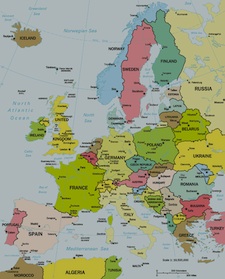
Gabrielle Marks/Flickr
It might seem like the economy is on the up but we’re not out of
the woods yet – we’re all still trying to stretch our pounds as far as
we can. With the the weekly shop still making a significant dent in our
hard-earned cash and the supermarkets up to all kinds of tricks to get
us to spend more money, what better time to learn how to beat them at
their own game?
- Make your food go further
- Tricks to look out for
- Savvy Shopping
- Find the best deals on MySupermarket
Make your food go further
First off, if you make some adjustments at home you won’t have to go
to the supermarket as often, which is one easy way to solve the problem!
- Keep a good supply of canned, frozen and dried foods you know everyone in your household will eat. That way, even when your fridge is looking a little sad, you’ll still have options and won’t have to rush out for extras.
- According to the excellent Lovefoodhatewaste website a shocking one third of the food we buy in the UK gets thrown away. They explain that it’s largely related to dishing up portions which are too large. You can check out their portion planner to avoid this. They’ve also got some brilliant recipes for using up your leftovers, and they’re not complicated, so think before you throw!
Preventing food waste should be one of your top priorities; as well
as making a significant environmental impact, you’ll theoretically be
saving a third on your food bill!
Look out for their tricks
Obviously you can’t avoid the supermarket forever, (now isn’t that a
nice thought?!), but you can be aware of all the marketing ploys and
save some serious money on your shopping trip whilst helping your health
and the environment.
Sweets and goodies near the checkout
Convenient isn’t it? Supermarkets love to prey on tired, hungry and
irritable shoppers. But don’t get caught out like this. Never go
shopping when you’re hungry. It might sound obvious, but you’ll end up
buying things you don’t need, and more often than not they’ll be
unhealthy and expensive.
Pretty packaging
Ooh, the Tesco Finest cheddar cheese looks delicious….but wait a second, it’s all about what’s on the outside.
The reason we don’t tend to buy a supermarket own brand produce is
because they purposely package it to appear bland and unappealing.
However own, basic or mid-range brands more often than not offer better
value for money than Tesco Finest or Sainsbury’s Taste the Difference
for instance.
As well as costing less, they’re also often equally as tasty. Why not
test a few out on your family and see if they can tell the difference?
OK, it doesn’t work in every case, but you’ll get to know which items
really are the best value.
Special Offers
We all love a special offer. Big writing and colourful signs make us
feel like we are winning and the supermarket is giving us something for
free. This is NEVER true. Suppliers pay the supermarkets handsomely to
have their products placed in a prime position and on special offer
because they know it will get customers to buy their product, even if
they wouldn’t usually.
Buy-one-get-one-free offers can be useful, but only if you were going
to buy the product anyway. Buy two for £X can also be good, but always
remember to look at how much the item costs individually. Then if the
saving when buying two is significant, it’s probably worth getting the
deal – only if you needed the item in the first place though!
If there isn’t much of a saving, ask yourself if you really need two. If you don’t, don’t get it.
Getting 50% extra deals, or a certain percentage, can seem appealing.
However, these offers often tempt you to buy a brand you wouldn’t
normally get. If this is the case, always look at the price per Kg or
per 100g. This will allow you to compare exactly how much you are paying
for the amount of product. You’ll often find that even though you get
more with the brand on offer – you are actually paying more per Kg or
100g.
There is an easy way to avoid these – have a shopping list and stick
to it. If items are on special offer and seem like a bargain, people are
often coerced into buying them. If it isn’t something you use often, or
something you were planning on buying anyway, don’t be tempted!
Real Offers – product reductions
Supermarket stock that doesn’t shift gets reduced – we’ve all seen
it. These are not like the bargains supermarkets brag about, they are genuine bargains.
Take advantage of them by finding out when your local supermarket
gets rid of its stock (this is usually later in the evenings or on
Sundays). Much more produce will be sold at bargain prices as it reaches
its use by date and most of the things you buy you’ll be able to freeze
so you won’t have to use them straight away.
Dirty display tricks
Did you know that supermarkets stack their shelves tactically? They
put the most expensive items right in your eye-line to make you spend
more. Look above and below and you can often get better deals. This also
works on your kids sitting in the trolley. Items are positioned so they
reach out and grab the top of the range products. It’s no coincidence
that the finest range of organic cereal is at their eyeline when you’re
looking for own brand cornflakes…
The first way to get around this is look at the whole range and compare the prices. Don’t grab and run.
Secondly, if you can, leave the kids at home. That way they won’t
distract you from finding the best value items or get their hearts set
on the most expensive items.
Also, men are apparently more susceptible to eye catching displays in
supermarkets – so be strong guys, or suggest that perhaps after all the
weekly shop is a job for the ladies.
To show just how sneaky supermarket displays are we did a little research at our local Tesco.
| Biscuits | Butter | Bread | Crisps | Cereal | Toilet Roll | |
| Top shelf | 65p | £1.29 | 61p | 46p | 85p | £1.96 |
| above middle | £1.28 | £1.31 | 99p | 30p | ||
| Middle shelf | £2.54 | £1.92 | £1.14 | 51p | £2.32 | £2.05 |
| below middle | £71p | £1.65 | £1.19 | 40p | £2.12 | |
| Bottom shelf | 26p | 72p | 28p | £1.53 | £1.99 | |
| Maximum saving | £2.28 | 63p | 58p | 23p | £1.47 | 9p |
This table clearly shows just how much more expensive the product in
the middle of the shelf (right in most people’s eyeline) is. So give
your neck some exercise and shop around on the shelf.
The supermarket maze
Believe it or not, all supermarkets follow a similar overall layout.
Fresh produce; fruit, vegetables, meat and dairy are all stocked around
the outer limits of the store whereas pre-packed, processed and frozen
foods are placed in the centre of the store.
They do this on purpose. It means that to get to the stuff you need
for your diet, you have to look at all the stuff you don’t. Then as you
work your way through the aisles, you buy stuff you don’t need. You
therefore spend more and they make more. Cunning isn’t it?
They also keep staples such as bread and milk towards the back of the
store in an attempt to get you to walk past almost everything else to
find them. Plus, if you’re looking for tea bags, it’s no coincidence
that biscuits are just next to them. Supermarkets pair up like for like
products knowing that you’re more likely to end up buying both.
You can beat them at their own game. Help your health and your wallet
– stick to the perimeter. If you have to go into the middle, use the
aisle signs to go straight to the product you need. Then you won’t be
looking at unneccessary items.
‘Convenient’ bags and packets – loose is cheaper
When you’re whizzing round the supermarket thinking about ten other
things at the same time, it’s easy to opt for pre-packed items.
But, buying items like fruit or vegetables loose, is invariably
cheaper than buying them in bags or packets. This is because the
supermarket has to pay someone to pack them. They also have to pay for
the materials and the overheads for the factory where they pack them
which all adds up to a bigger price tag.
Do it yourself for free. You’ll also help the environment by saving on packaging and producing less waste.
Weight comparison
Supermarkets have to give the price per weight or volume of each
item. It’s written underneath the price in much smaller writing. This is
great for shoppers as it means we can look at how much the item really
costs per 100g or kg. This way we can easily see how much we are really
paying for an item and it helps us compare.
However, to trip you up, supermarkets tend to show the price per unit
in different amounts for similar products. For example they might mark
own brand orange juice as 52p per litre and then they’ll mark Delmonte
orange juice as 8p per 100ml. This is meant to confuse you and stop you
being able to compare prices.
It’s easy to beat them if you know your metric measurements though. A
litre is 1000ml so that means that a litre of Delmonte costs 10 times
8p – 80p. This is actually more than the own brand, but it seems like
it’s less when you just look at it because of the smaller unit
measurement.
Don’t let them fool you. Get measurement savvy and get the most for your money.
Our Shopping Trip
To put our tips into practice, we went on a shopping trip of our own
to see how much we could save. Here’s the impressive (if we say so
ourselves!) results:
| Shopping List | Most Expensive Option | Cheapest Option | Saving |
| Peaches | £1.98 pack of 6* | £1.28 punnet of 6 | 70p |
| Royal Gala Apples | £1.15 for 5 (approx 650g) pre-packed | 90p for 5 (approx 650g) loose | 25p |
| Tomatoes | 69p for 6 (approx 400g) pre-packed | 67p for 6 (approx 400g) loose | 2p |
| Red Onions | 79p for 3 (approx 525g) pre-packed | 52p for 3 (approx 525g) loose | 27p |
| Granary Loaf | £1.09 from the instore bakery | 95p off the shelf | 14p |
| Cheddar Cheese | £4.42 for 500g – store luxury brand | £2.73 for 500g – store budget brand | £1.69 |
| Total – £10.12 | Total – £7.05 | Total – £3.07 |
*Advertised as ’50% extra free’!
You get the idea - we saved a massive 30% on our shopping bill, and
that’s just one small shopping trip. So if you spend about £100 on your
weekly shop, you could be saving as much as £30 a week! That’s a
serious saving over a few months or even a year.
Top Shopping Tips
Here’s just a few extra tips to help you save as much as you possibly can:
- Before you go shopping have a look on Mysupermarket. You can compare prices of any items at all the major supermarkets, so you’ll be well prepared when you reach the shops.
- Try not to visit the supermarket when all you need is 2 pints of milk – you’ll just end up buying things you don’t need, as well as wasting time and petrol.
- Try eating one or two vegetarian meals a week and you’ll be able to cut back on the meat you buy and save a small fortune.
- Buy fruit and vegetables that are in season – not only is this better for the environment, it’ll help your wallet too! Produce shipped from overseas incurs more transport costs and is therefore always more expensive.
- It’s not always cheaper to buy in bulk if you end up throwing loads of food away. However you can buy staples (like rice and pasta) in bulk since they work out cheaper, last for ages and you know you’ll always use them. Its worth checking out the bargain basement supermarkets such as Aldi, Lidl and Netto for these kind of products as well as for things like salt, sugar and flour.
- Once you’ve been round the supermarket and got everything you think you need (want), go through the basket just before you get to the check-out. Do you really need that jar of cajun fish relish? Or was it just displayed enticingly? Take out items that you don’t really need before you get to finally pay for your goods.
Got more of your own savvy shopping tips? Share them with the other Moneymagpies on our forums.

 As
I’ve been planning my move to Sweden, I’ve been trying to figure out
how to get past the 90-day limit placed on tourist visas. This is a
problem encountered by travelers every year and a question that
regularly pops up in my inbox.
As
I’ve been planning my move to Sweden, I’ve been trying to figure out
how to get past the 90-day limit placed on tourist visas. This is a
problem encountered by travelers every year and a question that
regularly pops up in my inbox. When
most people ask me about staying in Europe, they mean staying longer in
the Schengen zone. After all, it covers 26 countries and visiting so
many destinations in 90 days can be a little rushed (it is an average of
3.4 days per country).
When
most people ask me about staying in Europe, they mean staying longer in
the Schengen zone. After all, it covers 26 countries and visiting so
many destinations in 90 days can be a little rushed (it is an average of
3.4 days per country).










